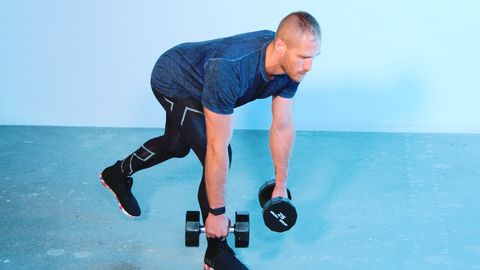The single-leg deadlift is a valuable addition to your training routine that can help build hamstring and overall posterior chain strength, but are you sure you’re even doing the exercise correctly?
For this movement, you shouldn’t settle for anything other than perfect form—especially because it’s such a simple, essential exercise that can serve as one of the centerpieces of your training plan. Let Men’s Health fitness director Ebenezer Samuel, C.S.C.S. and associate fitness editor Brett Williams guide you through the move’s subtleties, saving you from the bad habits that are keeping you from unlocking your fitness potential.
Before pick up your weights and start hinging up and down and swinging your leg back, take note that it’s extremely important to pay attention the movement here. Your positioning is essential to make sure you’re getting the most out of the exercise—particularly because the way that many trainers teach it wastes a ton of movement and can throw off your balance. Let’s break down everything you need to know.

Men’s Health
Shoulder Blades Tight
Eb says: The single-leg deadlift will make you focus on the working side hamstring and glute more, but remember this is a full posterior chain move. That means you want your entire back engaged as you lower the dumbbells.
This will give you a little back burn—and it will also help safeguard your shoulders as you start to move heavier weights, protecting your biceps tendons. This will help you keep yourself from rounding your back, too.
Don’t Overextend
Eb says: The standard single-leg deadlift is typically taught with you extending your non-working leg as far back as you can, aiming to keep it in line with your torso. That’s fine, but it can also create a major balance challenge, and oftentimes, that balance challenge overtakes your ability to utilize overload and time-under-tension principles with this deadlift.
That’s why I prefer to teach the move without that pendulum effect on the back leg. Instead, just lift your back foot off the ground and keep it off the ground. You’ll be able to add more weight to this deadlift, and you’ll still face a balance challenge, but your mind won’t be over-occupied trying to make sure your back leg is fully in line with your torso the whole time.
Stay Balanced
Eb says: We’re still going to keep a balance component in this single-leg deadlift: Try to complete your reps without letting your non-working side foot touch the ground. (If it has to touch, let it do so every few reps, but fight for balance).
This will insure that you don’t miss the final moment of the deadlift motion, when you’ll need to squeeze your glutes to stay in balance, driving your hips into extension. That’s a key mechanism in any standard bilateral deadlift, and we want it to be a key mechanism in this move too.
Don’t Go Low
Eb says: Focus on keeping a flat, straight back the entire time. That will very likely mean you need to stop lowering your torso earlier than you think. Your goal is to stop lowering your torso and pause once it’s parallel to the ground, or once you start to feel your back round, whichever comes first. This will be different for different people.
If you have tighter hamstrings or back issues, you won’t lower all the way down. If you have great flexibility, you’ll be able to lower until your torso is nearly parallel. Work in your own mobility. And know that this move is deceptive: Most people think they can lower their torsos until they’re parallel to the ground, but they go way too far. Don’t be afraid to stop early, feel your hamstring tighten, then push back to standing. And don’t be afraid to take video of yourself; this is one move where it’s invaluable to see your body positioning.
Want to master even more moves? Check out our entire Form Check series.
Source: Read Full Article
